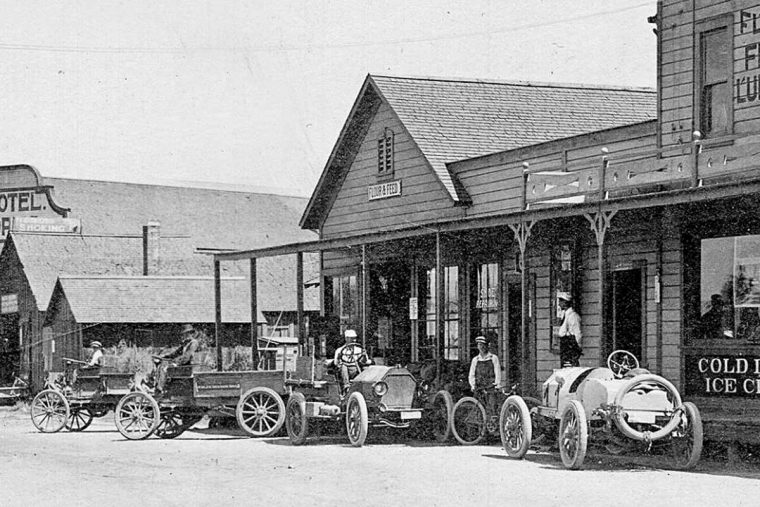To finish out the week here we have a pair of unique images of high-performance early automobiles parked on a street in different locations. The lead photo contains an impressive American Underslung “Traveler” on the left and a large and powerful Thomas-Flyer “6-70” roadster or “speedster” parked out in front of the Upham Gas Co. Both of the vehicles were owned by family members who owned and operated the Company.
The American appears to be as delivered when new, although the “6-70” Thomas looks like a “Hell Bent for Leather” semi-stripped down high-speed road car. It is equipped with a Cambridge windshield, and side curtains to keep the blast of cold winter of air off of both the driver and passenger at speed. A bearskin coat and hat, along with a face mask, goggles and heavy gloves were also necessary to keep the occupants from turning into a block of ice while underway.
Learn more about the “6-70” Thomas and the American Underslung “Traveler” in our earlier coverage.
This second circa 1910-’15 photo was taken in the center of Cotati, CA, “The Hub of Sonoma County” located forty miles north of San Francisco. Left-to-right are a pair of “high wheeler” trucks, what apparently is an automobile converted into a light truck, and what at first glance appears to be a 1911 to ’14 Mercer “Raceabout”.
If this car is actually a Mercer it is a converted 1911 to’14 touring car or 1914 roadster as the chassis has three-quarter elliptic rear springs as opposed to the “Raceabout” which is equipped with semi-ecliptics. What is more likely the case is this machine was a conventional thirty or forty h.p. car produced by another automaker converted into a “speedster.”
Share with us what you find of interest in these photographs courtesy of the Michael J. Semas Collection.



The first Muscle Cars. Thank you Dave for all your time and work on The Old Motor.
A quick “google” of Upham Gas co. reveals that it was in Mineral Wells, Texas.
Texas? Why the cold weather gear and chains? I see it is near Dallas/Ft. Worth. That is very curious.
The photo was obviously taken during the winter. Note the tire chains and snow. Why does the car on the left have the windshield and top down? I know that tops and side curtains didn’t offer much protection from the elements but there is some shelter provided by them. Tough people back then I guess. Zeke
Chains for mud! Plenty of that in Texas for early motorists.
I’ll take the cut down truck and the murdercycle, you can have the Mercer.
Deal.
For what it’s worth, factory Stutz racers were painted white like the racer in the third photo.
How do I know it’s a racer?
No fenders or lights, very unlike PRODUCTION Mercer Raceabouts, Stutz Bearcats or other sports cars.
I would think that the tire chains were for muddy roads, as I live about 50mile from Mineral Well, seldom do the conditions in winter warrant chains for ice and snow, as it is bare minimum in the winter.
David, thanks for posting superb pics of the early cars, please, more of this in future .
I see a “horse shoeing” sign on the left side of photo number two on the roof of the building next to the Hotel sign. Without a doubt a much more common mode of transportation on the day that pix was taken.
The high-wheelers on the left of the second photo were probably purpose-built in that configuration and the one on the right looks very much like a Galloway Auto Transport, made in Waterloo, Iowa. They were intended as practical vehicles for farmers that needed to haul produce and equipment as well as people, very much like pickup trucks today.
A 1915 Galloway ad pitched them this way: “What in the world is the use of keeping two, four or more horses on the farm and feeding them corn worth 75 cents a bushel and oats worth 35 cents to 40 cents, and hay worth $12 to $20 per ton and even more (if you live near some big city), when Galloway’s new auto transport (pleasure car and auto truck in one) can get more actual road work and hauling done in three hours than three teams of two horses each can do in a day?”
They sold for $570, “Complete, Ready to Run (But with Only One Seat).” A second seat was available for $12.
There was an “Upham Gas Co” in Mineral Wells, TX, but it didn’t have that name until 1950. This shot was taken on the west side of Public Square in Mount Vernon, OH.